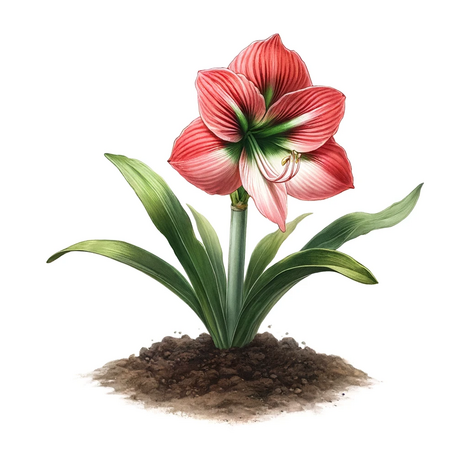Amaryllis

Amaryllis is a popular ornamental plant that is particularly popular at Christmas time with its large, colorful flowers. But many people don't know this: Amaryllis is very poisonous to dogs and can cause severe symptoms of poisoning. In this article, you will find out what amaryllis is, why it is poisonous, what symptoms poisoning causes and what you can do to protect your dog.
What is amaryllis?
Amaryllis (Hippeastrum hybrids) is a bulbous plant from the Peruvian Andes that belongs to the amaryllis family. It has narrow, green leaves and a thick stem with several funnel-shaped, slightly drooping flowers. The flowers can be white, pink, red or striped and have a diameter of up to 20 cm. Amaryllis is also known as knight's star and is available both as a cut flower and as a houseplant.
Why is amaryllis poisonous to dogs?
Amaryllis contains various alkaloids that have an effect on the nervous system and gastrointestinal tract of dogs. The most toxic substances are lycorine and amelline, which are found in all parts of the plant, but are particularly concentrated in the bulb. Just two grams of onion skin can cause severe symptoms of poisoning in a dog. The toxicity of amaryllis applies to all dog breeds and sizes.
What are the symptoms of amaryllis poisoning in dogs?
If a dog eats or chews on amaryllis, it may show the following symptoms:
- Increased salivation
- Nausea
- vomiting
- Diarrhea
- Stomach pain
- drowsiness
- skin irritation
- paralysis
- palpitations
- heart problems
- cramps
- tremors
The symptoms can vary depending on the amount and duration of the poison ingestion. Very severe poisoning can lead to cardiac arrest and death of the dog.
What should you do if your dog has eaten amaryllis?
Amaryllis poisoning in dogs is a life-threatening emergency that requires rapid action. If you notice or suspect that your dog has eaten amaryllis, you should take the following steps:
- Remove all visible remains of the plant from your dog's mouth.
- Call your vet or animal emergency services immediately and inform them of the situation.
- Take your dog to the vet or animal emergency services as soon as possible.
- If possible, take a piece of the plant or a photo of it with you so that the vet can determine the type of poisoning.
- Follow the vet's instructions and keep them informed about your dog's condition.
The vet will try to remove the poison from your dog's body and treat the symptoms. They may take the following measures:
- Give activated charcoal to bind the poison in the stomach and excrete it.
- Give laxatives to empty the bowel.
- Induce vomiting to remove the poison from the stomach.
- Give infusions to compensate for fluid loss and stabilize the circulation.
- Give medication to relieve heart problems and cramps.
The prognosis for your dog depends on the severity of the poisoning, the speed of treatment and your dog's general health. In some cases, there may be permanent damage to the kidneys or heart.
How can you prevent amaryllis poisoning in your dog?
The best way to prevent amaryllis poisoning in your dog is to avoid bringing the plant into your home in the first place or to keep it where your dog cannot access it. If you want to have amaryllis as a cut flower or houseplant, you should take the following precautions:
- Place the amaryllis out of your dog's reach, for example on a high shelf or in a locked room.
- Remove any fallen leaves or flowers from the amaryllis and dispose of them safely.
- Watch your dog when he is near the amaryllis and distract him if he shows interest in it.
- Train your dog not to eat or chew on plants.
- Find out about other plants that are poisonous to dogs and avoid them too.
Amaryllis is a beautiful but dangerous plant for dogs. It contains various alkaloids that can cause severe symptoms of poisoning in dogs. If you suspect that your dog has eaten amaryllis, you should contact your vet or animal emergency services immediately and have your dog treated. To avoid poisoning your dog with amaryllis, you should either not buy the plant in the first place or store it so that your dog does not have access to it.
Properties 6
Are you looking for other ingredients with a specific property?
Just click on them to find more.
If you notice any signs of hypersensitivity or poisoning in your dog, you should see your vet immediately. We are not a substitute for a vet, but we try to be as accurate as possible. Every dog reacts differently and we recommend you get a second opinion or consult your vet if in doubt.
Stay healthy and take good care of your four-legged friend!😊
Similar to Amaryllis
The knight's star (Hippeastrum) belongs to the amaryllis family (Amaryllidaceae) and is closely related to the belladonna (Amaryllis belladonna), which is also known as the amaryllis. The two plants...
Clivia is a genus of plants in the amaryllis family, originally from South Africa. It has long, dark green leaves and forms an inflorescence with many orange or yellow flowers in spring or summer....
Guernsey lilies (Nerine bowdenii) are bulbous plants known for their showy, pink flowers. Originally from South Africa, they have found their way into gardens and homes around the world, often...
Jewel lilies (Agapanthus) belong to the Amaryllidaceae family and are originally from southern Africa. They are perennial plants known for their long stems that rise above the foliage and end in...



